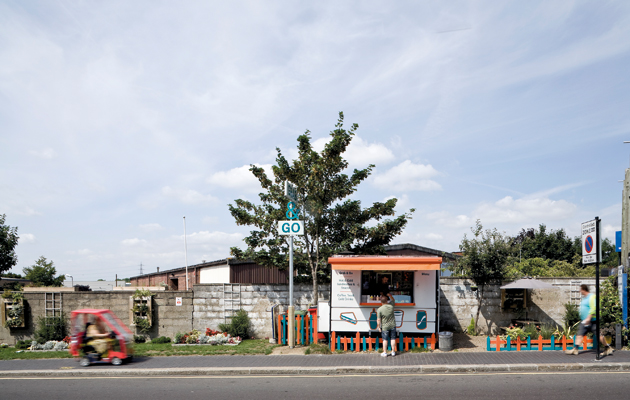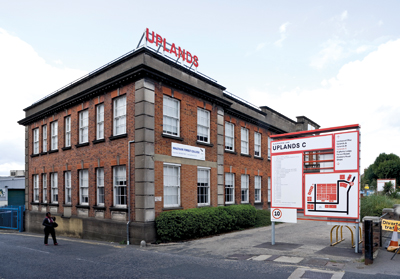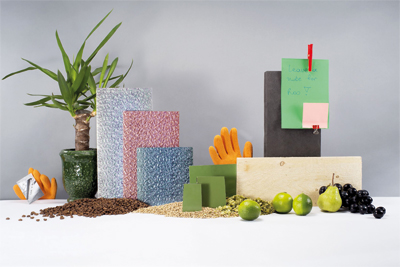|
|
||
|
The East London-based studio, whose masterplan for Blackhorse Lane in Waltham Forest has picked up the inaugural Mayor’s Prize at the New London Architecture awards, uses design to reinvigorate communities. Given the UK’s current political climate and the growing pressure of the housing crisis, its work has perhaps never been more crucial After almost ten years in operation, public-realm specialist We Made That has established a unique form of practice, eschewing the private sector in favour of agenda-driven design projects that help local government to create and preserve thriving communities. Co-founded by Holly Lewis and Oliver Goodhall, the studio’s core aim could perhaps best be described as social enrichment. The pursuit of this goal has taken a variety of forms over the last decade, from the expected architectural and urban design interventions to expansive research projects that often play an advocacy or advisory role. Speaking at Icon’s House of Culture during this year’s Clerkenwell Design Week, Lewis explained the importance of the studio’s work during an era of decreased state provision: “Ninety per cent of our projects are for local authorities, an admittedly difficult position given the political and economic context that we’re in and the ongoing rounds of cuts to public funding. We work with our clients to develop specific tactics to respond to their particular challenges.”
Holly Lewis (who spoke at Icon’s House of Culture in May) and Oliver Goodhall at We Made That’s Dalston base in east London For We Made That, a typical project will be something akin to its recent regeneration scheme for a high street in Walthamstow, grant-funded by the local authority with the intent of reinvigorating a confused streetscape, reconnecting it with a disenfranchised local population. But the studio’s remit is much broader. A more oblique side to its work – one that shades into advocacy rather than architecture – is represented by its Open Office events series for the Architecture Foundation that engaged over 600 people in discussions about the urban realm – a kind of “Citizens Urban Advice Bureau” that explored topics relating to the 2011 Localism Act. Lewis is particularly enthused about this aspect of the studio’s agenda, aiming to convince public bodies, and the public themselves, that money placed in the hands of community groups can go much further than it would if used by local authorities, while also having several fringe benefits. Letting people “do it for themselves” is something We Made That believes should be a fundamental strategy for improving Britain’s cities: “We think that these sorts of initiatives can play a very significant role, if only because they mean that there are groups of people all over the country with no professional background in the built environment talking about planning,” Lewis says. “This isn’t the typical relationship that communities have with their urban realm, which usually takes the form of protesting against a new tower block down the road, for example, or navigating the bureaucracy of a planning application. This is a different, and, crucially, positive way for local people to talk about how they create their city.” While much of We Made That’s past work has stemmed from a need for councils to reseed money raised from private developers back into the immediate locale, a new strategy that the studio has employed looks to pre-empt that process. By applying its expertise to the councils’ plans to court inward investment, We Made That can ensure that the sort of public-realm improvements traditionally funded as part of this turnover of private capital are made central to a masterplan at the earliest possible stage, rather than being added in a compromised manner after the fact. As local government loses the necessary resources, there is a growing reliance on practices like We Made That to step in. “There’s always going to be a role for the public sector to guide regeneration and we feed into that, whether on the developer side or the public-sector side,” Lewis explains. “That process will continue regardless of where the funding originates – in fact it becomes ever more important to have someone to mediate between these two forces to still ensure civic outcomes.” Blackhorse Lane
We Made That led a team working with the London Borough of Waltham Forest on its regeneration programme for Blackhorse Lane in east London – a project that was recognised at the 2015 New London Architecture awards. This particular street has an incredibly broad range of uses, from industrial activity to small retail units, as well as large numbers of residential buildings. The project aimed to reinvigorate this space and release its obvious potential by using public-realm improvements, alterations to the industrial-estate frontages and wayfinding interventions. The practice wanted to support businesses through not just physical enhancements but also more diffuse means. For example, it commisioned photographer Thomas Adank to document the businesses within the industrial sheds, whose use was obscured from residents, making the public reassess something that had seemed familiar. The studio also used these images to give the business community a new online presence and potentially direct more money into the local economy.
Above and top: The studio’s Blackhorse Lane project featured additional signage, graphic overlays and street furniture London Legacy Local Economy Study
As part of their LLLE study, We Made That used still lifes to illustrate the local business community Commissioned to undertake a study of businesses operating in the areas surrounding the fomer Olympic Park in Stratford, We Made That used its experience of performing qualitative assessments of environments and communities to create a report to accompany the opaque quantitative data that such government projects commonly produce. Taking the form of an illustrated book, the study helped to humanise the business community. The publication also made recommendations on how to support the local economy based on first-hand knowledge of the employers and the links between their workplaces and placemaking – the things that were contributing to making Hackney Wick into Hackney Wick, for example. In the process, We Made That uncovered and championed a range of surprising enterprises across the area, including juice made from “waste” fruit, a resurrected beer brand, internationally known artists and London’s only hand-made spectacle-frame factory |
Words Peter Maxwell
Above: The studio’s Blackhorse Lane project was yesterday awarded New London Architecture Mayor’s Prize |
|
|
||
|
Above: The duo discuss their work |
||























